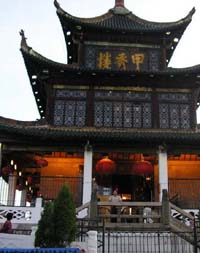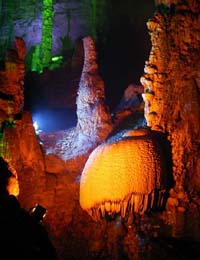Mountains, caves, lakes, streams, waterfalls and staggering geological wonders are the natural attractions of Guizhou but the the various ethnic minorities have made it China's most diverse province culturally, writes Tan Weiyun.
For many travelers, a trip to Guizhou Province in Southwest China, one of the country's most untapped regions located far from the coast and major rivers, means a tiring journey over bumpy mountainous roads and impoverished townships and villages that are dotted around the drought-stricken, barren landscape.
Yes, it is poor and backward but thanks to its geographical location, Guizhou has also been acclaimed as the "Switzerland of the Orient" and is a wonderland that has kept its natural sights exactly as they were millions of years ago.
Located to the east of the Yunnan-Guizhou Plateau, the province covers an area of 176,000 square kilometers, of which 75 percent are mountains and plateaus.
Famed as a "Kingdom of Mountains and World of Waterfalls," Guizhou is truly a vast land of treasures as its name in Chinese indicates - "place of riches."
Its terrain is rugged with underground rivers, thousands of limestone caves, jagged peaks, cascading waterfalls, jade-green forests, dramatic valleys, terraced rice fields and Karst formations, a unique landscape shaped by the dissolving of soluble layers of bedrock over thousands of years.
Huangguoshu Waterfall, China's largest, is a must-see scenic spot in the southwestern part of the province. It is 74 meters high and 81 meters wide, so large that the booming of the water over the falls thunders in visitors' ears from long way off.
A cave in the cliffside, partly hidden behind the curtain made by the huge sheet of water tumbling down from the top, looks like a fairy world.
In the southern tip of Guzhou is Libo County, a nationally ranked scenic spot and a Karst-protected area, dominated by forest settings and surrounded by winding streams.
About 90 percent of its residents are from the Buyi, Shui, Miao and Yao ethnic groups.
The Tianzhong (Heaven Bell) Cave is the No. 1 attraction for tourists. The cave is divided into the Crocodile, Golden Cock, Rhino and Hundred Animals halls.
The cave got its name from a giant bell-shaped stone, covered with patterns resembling tadpoles, which was then considered t be the ruler of the animal world.
The Hundred Animals Hall is spacious enough to house more than 100,000 people. Numerous stories and myths have been inspired by the stones found in the hall. An awesome stone in the shape of a lion is in the center of the hall and a row of smaller stones resembling cats and dogs are in front.
The hall is like a solemn court and at the back, a Rhino who broke the law has been chained to a post for 9,999 years.
Zhijin Cave Scenic Spot is another highlight. It is famous for its massive, scale, stalagtites, stalagmites, stone pillars and stone pagodas in unbelievable heights and numbers.
Known as "The Museum of Karst Formation," the 30,000-square-meter cave has an average height of 50-60 meters with the highest point at 185 meters and the widest 175 meters.
There are more than 40 types of Karst precipitation formations in different sizes and shapes in the cave where clear, blue underground lakes and waterfalls are seen.
Eight large scenic areas, 19 halls and 49 chambers are open for display to the public.
Dragon Palace, which is located 32 kilometers southwest of Anshun City, is another splendid underground Karst-type cave.
Take a boat-ride into the underground cavern and you will feel like you are in a fairyland or a huge crystal world, overwhelmed by the sight of magnificent, grotesque rocks and stones.
On the right of the Dragon Gate is a 45-meter-high drop. Above is Tianchi (Heavenly Pool), also known as Dragon Pool, which is more than 10,000 square meters in area and with an average depth of 43 meters.
It is the source of the Dragon Gate Fall.
The Dragon Palace cavern contains narrow pathway and smaller caves filled with dripping stalactites and stalagmites in amazing shapes and sizes.
Caves, stones, waterfalls and mountains are Guizhou's fantastic four attractions, but the province still has more to offer.
The abundant fossils of Triassic Era marine creatures prove that Guizhou was under the sea 250 to 230 million years ago.
Some 4,000 types of fossils, ranging from fungus to mammals, and even evidence of prehistoric men have been found.
The Guanyin Cave Culture in western Guizhou is comparable to Beijing's Zhoukoudian Culture (Peking Man) and the Puding Chuandong Culture is considered as "the beacon of Asia civilization".
The Paleolithic Dadong Culture, located in Panxian County, China's top archeological find in 1993, proves that prehistoric men settled on the land some 240,000 years ago.
But the real beauty and essential charm of Guizhou lies in the province's diverse local cultures and its numerous ethnic minority villages.
Of China's 56 ethnic groups, 18 have made their home in Guizhou and they have lived there for thousands of years. With a total population of about 35 million, up to 38 percent of Guizhou's inhabitants are a mixture of different minority groups - Miao, Buyi, Dong, Yi, Shui, Hui, Gelao, Zhuang, Yao, Bai and Tujia.
They have lived there since ancient times, passing down their myths and legends, dances and songs, customs and rites, traditional costumes and festivals from generation to generation.
Various festivals are held by the groups all year round, such as the Bully-Fighting Festival for Buyi people in April, the Mao Festival among Shui people and China's oldest Valentine's Day, the Sasui Festival to commemorate a girl named Sasui who protects the Dong group.
Their unique architectural style, exotic, colorful costumes and folk dances and music will make tourists feel that everything in the world is new and fresh again.
Links: Guizhou Photo Gallery
(Shanghai Daily by Tan Weiyun August 10, 2007)



